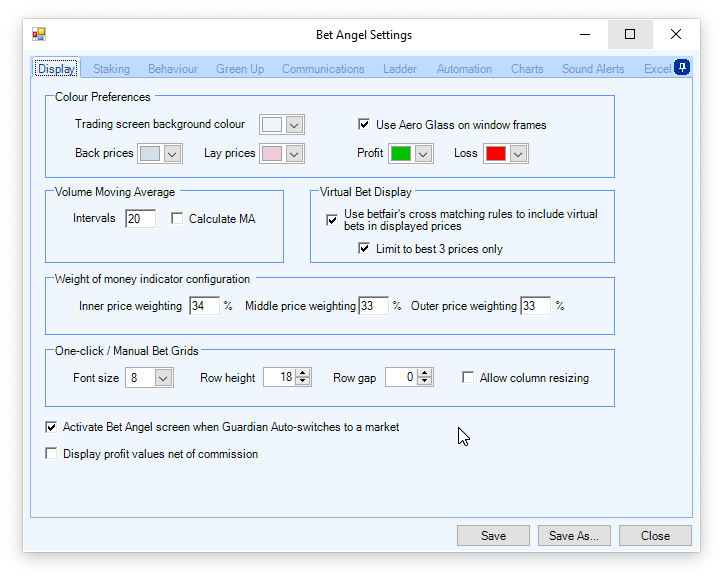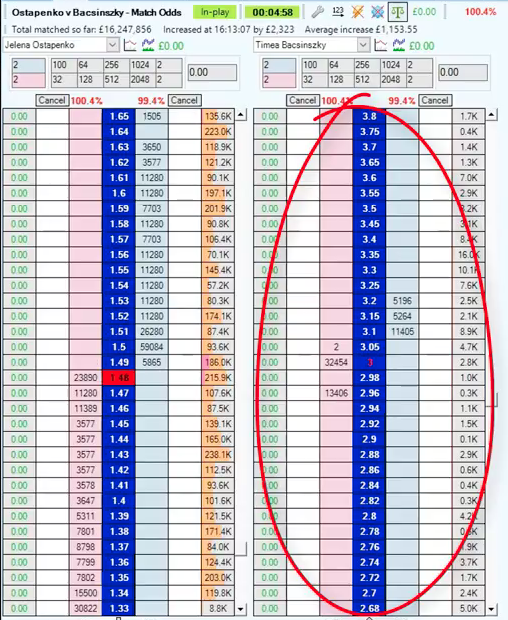Nobody will remember now, but a very long time ago in a galaxy far far away.
Well the first big was accurate at least, but there was a time when Cross matching on Betfair didn’t exist.
Betfair introduced cross matching in 2008. I remember it very well because, overnight, a number of Bet Angel users started reporting that some of their strategies had started to perform badly and they wondered why. So a bit of detective work led us to the reason and soon after Betfair formally announced the change.
So what is cross matching, what is the background to it and what impact does it have on a betting market?
What is Cross Matching?
When this concept was introduced on the Betfair exchange it wasn’t available via the API. So at Bet Angel we had to work it all out and put it in Bet Angel as an option. That option still exists.
So if you want to understand the concept and see it in action, you access the Virtual Bet Display via the settings menu. You can toggle it on and off while looking at a ladder, for example, to understand its impact.

Cross matching, or virtual bets as they are often described on the Betfair API documentation, are odds on offer in the market that were not offered by any particular individual.
If you are new to this concept, you may wonder who is actually offering these bets into the Betfair betting exchange, the answer is the Betfair cross matcher. Betfair themselves are putting these offers into the market.
The concept is that if you offer a bet on one side or one selection within a market then the same bet gets offered at reciprocal odds by Betfair elsewhere. If there was a two runner horse race with both horses at decimal odds of 2.00 then backing one runner at these odds is effectively the same as laying the other runner with the at the same odds.
So what the Betfair cross matcher does, in essence. Is look at what bet you have placed on the Betfair betting exchange and then take that unmatched bet and place it at reciprocal points elsewhere in the market. In layman’s terms, it duplicates your bet and puts it elsewhere. You are probably not even aware that it is happening.
I explained the concept about cross matching in a video here, but more specifically you can see it live on a Tennis match on this video. In the illustration you see below all the unmatched bets on the right ladder in this Tennis match, are completely virtual, they don’t exist. Watch the video if you want to see that for yourself.

Why was it introduced?
The concept that Betfair posited was that it would help increase liquidity. But I’ve always been pretty suspicious of it. You will learn why in a bit, but fundamentally speaking there was nothing wrong with the way the market was working before it was introduced.
Sometimes a large order would hit the market and send a price way off its touch price, but the market would eventually soak it up that order and find it’s correct price. After cross matching the market always ‘hugged’ a 100% book and therefore a large order wouldn’t move the price, just spike in the direction of the order and send everything else out in the opposite direction. Not a true reflection of the market at all.
However, I knew from Betfair’s conference calls that creating a more competitive market where neither side on the exchage dominates each other leads to a higher gross yield for Betfair. If nobody wins too much, then Betfair wins more. I always felt this was a stronger case for implementation.
Cross matching controvesy
Shortly after cross-matching was introduced it hit some controversy. Of course, a lot of people are upset at the fact that the strategies didn’t seem to work the way that they should do. But the key issue surrounding its controversy was that while it was positioned that it would be beneficial to liquidity, I noticed that the fill rate had changed on quite a few markets, I wasn’t getting my orders matched as frequently as I used to.
That was nothing however compared to the fury that enveloped various communities when it turned out that Betfair was not calculating reciprocal stakes in the same manner that you would expect given reciprocal odds. This meant that there was a small rounding error, in Betfair’s favour of course. That meant for each bit of cross-matching that they did, they were getting a small amount of margin.
It was tricky to quantify exactly how much was being taken off the table, but obviously wasn’t something that was expected or wanted. I’ve gathered some additional information on this to add to this blog post. But I ran out of time on this occasion to squeeze it in. I’ll add it soon.
But to round off here is a detailed description of exactly how cross matching works: –
A detailed description of the cross matching process
Betfair kindly wrote to me recently to clarify some key points around cross matching. This explains how cross matching works in general, but also how orders are specifically matched .
It’s easier to focus on a two runner market to explain cross matching as it gets more complicated when you go above this value.
Two runner cross matching
Conceptually cross matching is very simple. If you want to back a selection in a 2-runner market, there are two ways that we can get your bet matched: against a layer of that same selection, or with a backer of the other selection. For example backing Djokovic at 1.5 is identical to laying Murray at 3.0.
When you place a bet, instead of considering just one of the sets of unmatched bets with which Betfair could match you, we consider both. If you place a bet that isn’t immediately matched, we advertise it to other customers both ways that we could match it.
There are two ways we could match you, so we display both on the site to give you the best chance of getting matched. These bets can be matched in exactly the same way as any other bet.
How bets are matched
Betfair confirmed to me that when bets arrive on the exchange they will be matched in the following manner: –
(1) Price
(2) Where prices are the same, lay bets against back bets in preference to cross matches
(3) By Bet ID (i.e. in time order)
In other words every time you place a bet we look at the regular match (back vs. lay), and cross matching only comes into play if that would get you a better price than a regular match (or if it matches a bet that would otherwise remain unmatched).
Reciprocal pricing
To answer what happens at odds which don’t have a direct reciprocal on the odds ladder, an example would be useful.
If you attempt to back Djokovic at 1.98 for £50 and your bet is initially unmatched, then we can show that to other customers in two different ways: £50 available to lay Djokovic at 1.98 of course, but we could also show it as available for Murray backers.
2.02 is the best price on our ladder that we could offer, for a stake of £49.01. So we could match a Djokovic backer for £50 at 1.98 with a Djokovic layer for £50 at 1.98, or we could match a Djokovic backer for £50 at 1.98 with a Murray backer for £49.01 at 2.02.
If you go back to the matching order answer above, you’ll see that matching lay bets against back bets in preference to cross matches means that if we have the choice of a cross match that makes us a penny or a regular match that doesn’t, we always do the latter.
The post Betfair Cross Matching (XM) – Explained appeared first on Betfair trading blog | Expert advice from Professional Betfair trade.
